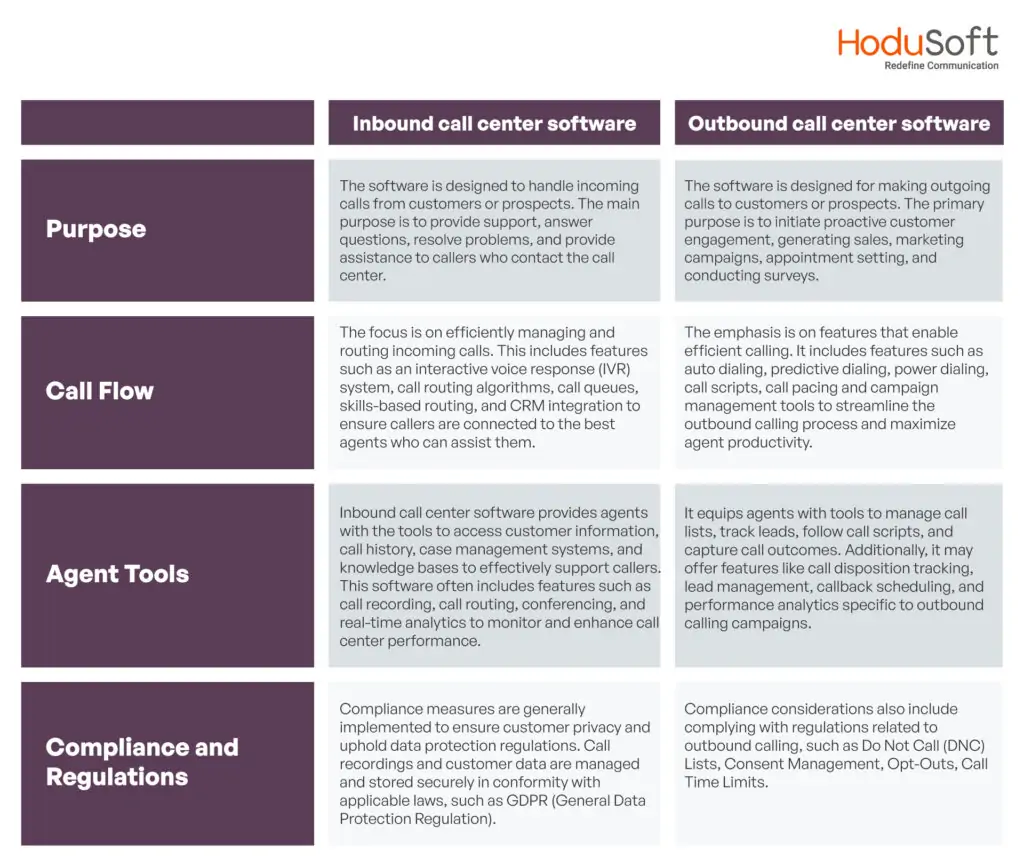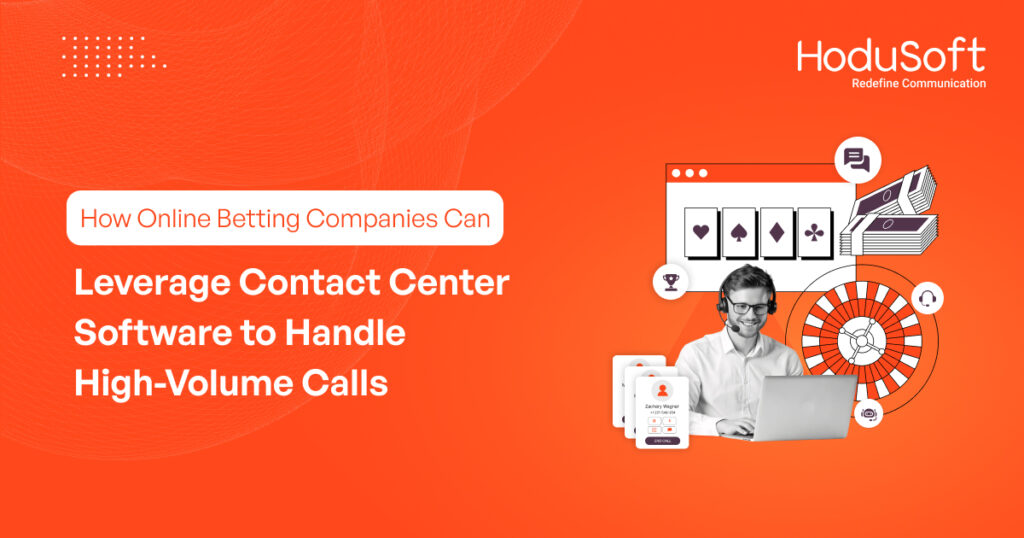In-Depth Guide: Inbound Call Center Software
Inbound call center software is an essential tool for delivering optimal customer service. It is designed to help businesses in efficient management and handling of large volumes of incoming customer calls.
Choosing the right inbound call center software can help businesses in improving customer satisfaction, reducing wait times, and increasing operational efficiency.
In this blog, we will explore everything related to inbound call center software. We are going the cover the following points-
- What is inbound call center software?
- Benefits of using inbound call center software for businesses
- How inbound call center software differs from outbound call center software
- Features of inbound call center software
- How to choose the right inbound call center software?
- Best practices for using inbound call center software
- Future of inbound call center software
What is Inbound Call Center Software?
Inbound call center software refers to a suite of tools and technologies used to manage and handle incoming customer calls within a contact center environment. It is designed with the intent of streamlining and optimizing the call handling process, improving customer service, and enhancing operational efficiency. .
Benefits of using inbound call center software for businesses
Inbound call center software can offer many advantages for businesses. Here are some of the key benefits:
Enhanced Customer Service:
Inbound call center software boosts customer service by offering features that help agents manage incoming calls effectively. Features such as automatic call distribution, IVR, and CRM integration make call routing more efficient, enable personalized communications, and give agents access to customer data which results in faster resolution to inquiries and improved customer satisfaction.
Improved Efficiency and Productivity:
The software streamlines call handling processes, automates repetitive tasks, and optimizes agent workflows to maximize operational efficiency. Agents are able to handle more calls in less time, enabling enhanced productivity. Furthermore, supervisors can leverage real-time analytics and reporting to monitor performance levels, identify areas of potential improvement, and make informed decisions for increased productivity.
Scalability and Flexibility:
Inbound call center software provides scalability to adapt to fluctuations in call volumes. Companies can easily add or decrease the number of agents and phone lines as required, ensuring efficient resource utilization. Besides, cloud-based solutions offer added flexibility by allowing agents to work from different locations, allowing organizations to more conveniently expand their operations or implement remote working models.
Cost Savings:
By automating call routing and leveraging self-service options such as IVR, businesses can reduce the need for additional staff and handle more calls with fewer agents. This can lead to cost savings in staffing expenses. Additionally, the cloud-based solution eliminates large upfront hardware investments and ongoing maintenance costs.
Improved Reporting and Analytics:
Inbound call center software offers comprehensive reporting and analytics capabilities, providing insight into call volume, agent performance, customer satisfaction, and other key metrics. These insights enable organizations to identify trends, measure performance against goals, and make data-driven decisions to improve customer service and operational efficiency.
Integration with Other Systems:
Many inbound call center software solutions offer integration with other business systems such as CRMs, helpdesk software, and ticketing systems. This integration enables smooth data exchange, giving agents access to customer information and interaction history, improving service quality and enabling personalized customer experiences.
In all, inbound call center system enables businesses to deliver efficient, personalized and consistent customer service, resulting in higher customer satisfaction, better operational efficiency and improved business performance.
How does inbound call center software differ from outbound call center software?
Inbound call center software and outbound call center software serve different purposes and address the specific needs of call center operations. Here are the differences between each:

Although there may be some overlapping features, the key difference between inbound and outbound call center software lies in their core functionalities and the specific needs they serve.
For call centers, it is important to choose the right software based on their operational requirements and objectives.
Features of Inbound Call Center Software
Here are some of the key features and functions commonly found in inbound call center software.
Automatic Call Distribution (ACD):
ACD is a core feature that intelligently routes incoming calls to the best available agent based on predefined criteria such as skill, availability, and priority. This ensures well-organized call distribution and cuts down customer wait times.
Interactive Voice Response (IVR):
IVR systems provide callers with automated menus and prompts, allowing them to navigate through various options using the phone’s keypad or voice commands. IVR systems enable self-service capabilities and help route callers to the right department or agent.
Call Queue:
When all agents are busy, Call Queue puts the caller in a queue and informs them of the estimated wait time and their position in the queue. This ensures fairness and orderliness in call handling and minimizes the risk of lost calls or frustrated customers.
Call recording:
This feature records incoming calls for quality assurance, compliance, and training purposes. It allows supervisors to review interactions, identify opportunities for improvement, and ensure agents are complying with company policies and customer service standards.
Customer relationship management (CRM) integration:
Integrating the call center software with a CRM system gives agents access to real-time customer information and interaction history during calls. This integration improves personalized customer service and provides agents with relevant data to efficiently resolve queries.
Real-time analytics and reporting:
Inbound call center software often includes reports and analytics that provide insight into call volume, agent performance, average handle times, customer satisfaction, and other important metrics. Real-time dashboards help supervisors monitor operations and make data-driven decisions.
Call Monitoring and Whisper Coaching:
Managers or supervisors can listen to live calls to monitor agent performance and provide real-time guidance through Whisper Coaching. This feature allows supervisors to guide agents without the customer listening, ensuring high-quality service.
Integration with other communication channels:
Apart from handling incoming calls, advanced call center software often supports integration with other communication channels such as email, chat, social media, and SMS. This multi-channel approach allows agents to provide consistent support across different platforms.
Skills-based routing:
This feature routes calls to agents based on their specific skills and expertise. This ensures that customers are connected to the most appropriate agents who can effectively meet their specific needs.
Call Scripts and Knowledge Base:
The Software includes a call script tool and knowledge base that provide access to pre-defined scripts, FAQs, and information archives to help agents respond to customer inquiries accurately and consistently.
It is important to note that the specific features or functions may vary depending on the software provider and the unique requirements of each call center.
Choosing the Right Inbound Call Center Software
When choosing inbound call center software, businesses should consider several factors to ensure they choose the best solution for their needs. Some of the important factors to consider include:
Scalability:
Consider software scalability to accommodate business growth. Determine if your software can handle increased call volumes, agent capacity, and additional features as your call center grows.
Features and Functionality:
Identify the specific features and functionality needed to meet your call center goals. Consider features such as ACD, IVR, call recording, CRM integration, real-time analytics, and reporting capabilities. Prioritize features that meet your precise business needs.
Integration Capabilities:
Evaluate software compatibility with existing systems and technologies used in call centers. It must integrate seamlessly with CRM platforms, helpdesk software, ticketing systems, or other tools used in your call center operations.
Ease of use:
Choose software that is easy to use and intuitive for both agents and supervisors. A user-friendly interface reduces training time and helps agents handle calls efficiently. Also, make sure that the software is easy to configure and customizable.
Reliability and uptime:
Consider software reliability and uptime guarantees. Downtime can have a significant impact on customer satisfaction and business operations. Look for software with proven stability and robust infrastructure.
Security and Compliance:
Data security and compliance are important factors, especially when dealing with sensitive customer information. Make sure your software complies with relevant privacy regulations and provides features such as encryption, access control, and audit trails.
Total Cost of Ownership (TCO):
Consider total cost of ownership which may include license fees, implementation costs, maintenance fees, and any additional costs associated with hardware, integration, or ongoing support. Estimate the return on investment (ROI) your software can provide in terms of efficiency, customer satisfaction, and improved business outcomes.
Reviews and Testimonials:
Read and delve into customer reviews and case studies to get testimonials from companies that have already deployed the software. Learn from their experiences and gain insight into the software’s strengths, weaknesses, and overall appropriateness.
All these factors can help businesses in making an informed decision and choosing inbound call center software that meets with their specific requirements, improves customer service, and enhances overall call center performance.
Best Practices for Using Inbound Call Center Software
To optimize the use of your inbound call center software and maximize its benefits, consider the following best practices.
Define clear goals:
Clearly define your call center goals and align them with the software’s capabilities. Decide which key performance indicators (KPIs) to measure and improve such as first call resolution rate, average handle time, or customer satisfaction scores.
Provide proper training:
Provide agents with comprehensive training on how to use the software effectively. Make sure they understand the features, call handling processes, and how to use tools such as CRM integrations and call scripts. Ongoing training and sessions can help agents stay up to date and proficient with the software.
Customize call flows and routing:
Customize call flows and routing rules within the software to suit your business needs. Build personalized IVR menus, design call routing algorithms based on agent skills, and configure intelligent queuing to ensure callers are immediately connected to the right agent.
Take advantage of CRM integration:
If your software is integrated with a CRM system, be sure to take advantage of this feature. Enable automatic pop-up windows that display customer information, call history, and case details. This empowers agents to provide personalized and efficient service, improving the overall customer experience.
Performance Monitoring and Analysis:
Regularly monitor and analyze call center performance using the software’s reporting and analysis tools. Track key metrics such as call volume, wait time, average handle time, and agent performance. It also helps in identifying trends, areas for improvement, and opportunities to optimize operations.
Continuously optimize workflows:
Regularly review and improve call center workflows based on data and insights from the software. Identify bottlenecks, exclude unnecessary steps, streamline processes to increase efficiency and enhance customer satisfaction. Get feedback from agents and customers to identify pain points and opportunities for improvement.
Utilize self-service options:
If your software supports self-service options such as IVRs, knowledge bases, and chatbots, encourage your customers to use these resources. Self-service options help reduce call volume and increase agent availability for more complex requests, resulting in shorter wait times and faster issue resolution.
Facilitate collaboration and knowledge sharing:
Facilitate collaboration between agents using features such as internal chat and conference calls within the software. Enable knowledge exchange through central knowledge databases and general FAQs. This allows agents to support each other, improve their problem-solving skills, and provide consistent customer service.
Update and maintain your software regularly:
Keep your software up to date with the latest releases and patches. Stay informed about the latest features and updates that may improve the performance and functionality of your software.
By following these best practices, businesses can effectively use inbound call center software to improve customer service, streamline operations, and achieve their call center goals.
Future of Inbound Call Center Software
The future of inbound call center software lies in the convergence of cutting-edge technologies such as artificial intelligence (AI), automation, omnichannel customer experience, enhanced personalization, advanced analytics, IoT integration, augmented reality, and advanced security and data privacy.
These advancements will enable call centers to deliver highly personalized and efficient customer interactions across multiple channels, leverage data-driven insights to make proactive decisions, enable remote collaboration, and advanced customer interactions.
Overall, the future of inbound call center software promises seamless, smart, customer-centric operations that lead to increased customer satisfaction and improved business outcomes.
Conclusion
To summarize, inbound call center software is a key tool for efficient customer service and support. It offers a variety of features to optimize incoming calls, improve agent productivity, and enhance customer satisfaction.
By leveraging the right software, businesses can optimize operational efficiency while delivering a superior customer experience.



